Avocado is an important commercial fruit grown mainly by both small and large scale farmers. The main avocado varieties grown for export market are Hass and Fuertes. In addition, three others are traded in the local market which includes Puebla, Duke, and G6.
“Exemplary great and growing fast!!” That was the clear answer from a Kenyan grower, when I went calling to understand the avocado market. “Global avocado consumption is growing by about three percent every year; however, production growth remains a little behind. Worldwide investments in the product are on the rise but cannot match the demand. For now, the market is big enough for all players involved”, he added.
When the Investor had engaged a consultant two years ago to understand the market which led him to the bank to apply for a loan, he wasn’t sure whether he will get his money back. He had no experience as a grower, he had just been retrenched as a civil servant and wanted to try his luck. The consultant was crystal clear to him. “If you do not know how the global sector operates you cannot get far with the investment. You need to understand the seasons and the market dimensions”, he told me as we toured his expansive farm. “Worldwide, investments in avocado are on the rise. However, consumption is growing rapidly especially in North America and Europe. Europe is recording high prices due to low supply but in America, prices remain at a reasonable level while China is a major import market”, he added.
World Avocado Production Review
“For a start, the market for avocado is one of the most dynamic in the fresh produce trade”, the grower told me. The demand of horticultural products is quite steady in recent years due to the economic downturn but the market for avocado is has been growing and is expected to grow about 2% per year at the world level and 2.6% in the European Union countries by 2018.
Understand the Market Dimensions
“You do not need to invest in the sector to compete but to compliment”, he began. “Therefore you need to understand the global production, the seasons and target market. This is the only way you will understand your entry point”, he went on. “So let us start our global tour from Mexico. Mexico focuses too much on their next door neighbours, the U.S. During the 2015/2016 season, they exported over 1 million tons of avocados worldwide. Of these, 860,000 tons were shipped to the United States and more than 15,000 tons to other markets. Down south in South America is Chile. The Chilean ‘Hass’ avocado industry is mainly exporting to China. The Chinese market which was opened in 2014 has sharply grown. Across the border is Peru whose exports are now stable. The demand for Peruvian avocados has been very good in several markets with a huge part going to Spain”, he said.
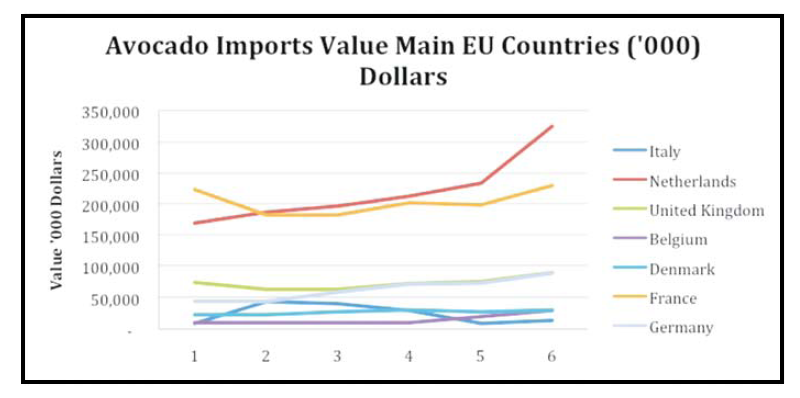 From America, the farmer took me to Europe where Spain is the main gateway especially for the Peruvian and South African avocados. The Spanish domestic market is also developing with consumption growing between 15 and 20 percent annually. In the Caribbean’s, where the seventh ranked exporter, the Dominican Republic is domiciled, avocado is a major export fruit.
From America, the farmer took me to Europe where Spain is the main gateway especially for the Peruvian and South African avocados. The Spanish domestic market is also developing with consumption growing between 15 and 20 percent annually. In the Caribbean’s, where the seventh ranked exporter, the Dominican Republic is domiciled, avocado is a major export fruit.
From the Diaspora, the farmer brought me back home. “Kenya has potential for production and export. In the case of ‘Hass’ avocados, Kenya has a potentially great production because it features the appropriate weather conditions. This variety hits the market in May, while the ‘Fuerte’ variety is available from March to September”, he told me.
Adding, “Kenyan avocados are shipped to different markets around the world, from Russia to Egypt. Exports are expected to continue growing in the coming years. Thanks to improvements in production and logistics, it is now possible to export to the Middle East and the European Union”.
On other parts of Africa, the farmer informed me our southern neighbour, Tanzania is also doing a lot of avocados and their volumes are expected to continue growing. While down south, South Africa export volume is growing slightly. A portion of the avocados remains in South Africa and are used locally. The African countries target the same market, Europe with Kenya biased to France.
Elsewhere, he said, “quality and sizes of the New Zealand Avocados are good with great prices and strong demand from Australia and Japan markets. Israel is expected to increase production compared to previous seasons.Israel has become one of the leading players in recent years as a supplier to the European market.
Kenya’s Avocado Growth, Trends and Potential The grower then introduced me to his consultant. My instincts dictated that I understand the life of an Avocado consultant. From the start we were in agreement that he will not see or introduce me as a journalist anywhere. We set up as colleagues and the day started at six in the morning. From the various growers we visited during our trip, I learned Avocado is an important commercial fruit grown mainly by both small and large scale farmers. The main avocado varieties grown for export market are Hass and Fuertes. In addition, three others are traded in the local market which includes Puebla, Duke, and G6.
The consultant’s data which he availed to me, showed in 2016, avocado contributed Kshs 4.63 billion from 246,057 tons of fruits accounting for 8% by value of the fruit subsector. The value increased from 4.45 Billion in 2015 to 4.63 in 2016 which was a 4.2% increase from 2015. The area under production increased from 10,383 Ha in 2015 to 11,017 in 2016 a 6.1% change that was attributed to planting of new orchards in non-traditional areas of the rift valley while production increased from 230,984 tons to 246,057 in 2016 representing 6.6% increase.
The consultant did his work diligently covering from seed to fruit. I only asked, “is there market for avocados, room for more investors and are farmers making money?” The three in one question was answered with a single answer of YES by every grower provided one meets the three main Importer Requirements
• Consistency
It is necessary a farmer is able to supply the market regularly during the marketing season: the quantities supplied must be constant in volume and precise according to the agreements established with the importers. In any case shipments must be prepared according to exigencies of varieties, quality, sizes, packaging and labelling indicated by the buyers. The fruits quality must be optimal in each shipment and in all shipments.
• Organization of the supply capacities
The importers must be guaranteed that the logistic for the products transport is effective and efficient alongside all steps of the supply chain so that the product can be shipped and delivered fresh. The supply chain cannot have any interruption from the packing houses to the selling point; the functioning of the cool chain during storage and transport must therefore be guaranteed.
• Product concept
The services related to the commercialization are frequently a crucial point in a buyer purchasing decision. The product concept nowadays does not refer to the only product itself but also to all services related to its commercialization such as the product preparation and presentation, the quality of the packaging, the precision of shipments, the follow-up of negotiations and supply as well as the products marketing and promotions.
Why Invest in Kenya
From my interactions with the growers, consultant and some other industry players, my conclusion was, investors should pack their suitcases and head to Kenya. Kenya is privileged by the facts that concurrence is lower in the middle part of the year and that at the beginning of its marketing season the products origins are shifting having in most cases smaller volumes and decreasing quality; on the other hand, it cannot dispose of big volumes at the beginning of the season.
However, the enhancement of the exports of avocado seems to need the strengthening of the collaboration with existing importers, for the consolidation of the existing market shares. The attention to the products concept should be worked together with trading partners in order to gain the confidence of the market accordingly to increasingly exigent market standards. This should involve products quality, sizes, packaging, product servicing, marketing and promotion.
This led me to a discussion with the investors in the different areas of the value chain. From carton suppliers to shippers through marketers, I realized they were far much ahead of the farmers and ready for any expansion. Anyone with the above information will be left with only one call, Kenya is ready for investors to grow Avocado.
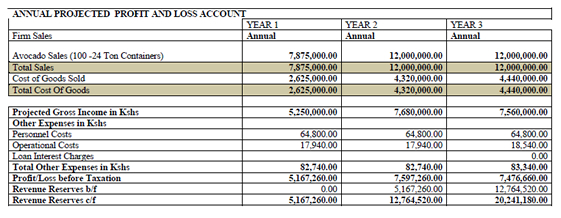 Why we need more Investors in Production, Technical Support and Marketing
Why we need more Investors in Production, Technical Support and Marketing
The consultant turned partner of the day agreed with most of the growers that, the initial development of the Kenyan imports of avocados was controlled by a number of large French importers who used Kenyan production to cover gaps in the market. However, the buying patterns in Europe have changed significantly and the French have lost their dominance. Kenya’s production can be classified as one of the best in the market. Small to medium-sized fruits are more suitable for the commercialization. Smooth, thin or fairly thin, pliable, green skin is preferred by the consumer. This is what is majorly produced in Kenya. This gives Kenya room to take over the Avocado market as it has done to the rose market. However they agreed that investors in the different parts of the value chain should:
- Invest in product quality and products concept (preparation, presentation, packaging and servicing), fruits quality, uniformity and precision of shipments would be essential and promotional campaigns supporting the marketing efforts extremely beneficial.
- Repeatedly positive season in terms of quality and precision of supply would reposition the image of the Kenyan avocado in evolved markets.
- Exploit as much as possible the periods of undersupply in March and September investing in earliness and length of the marketing seasons and related shipments plans.
- Target countries with high market growth rates (e.g. the Netherland) and emerging countries (e.g.: Russia, China, the Middle East) as well as emerging market segments (ready-to eat).
- Pursue markets diversification through a further development of the market linkages in relatively new markets (Mediterranean countries, Eastern Europe).
- Develop contacts in the Scandinavian market where small sizes are in demand.
- Enhance the regional market as the product development expected in evolved markets would be facilitated by a strong trade at the regional level.
- Diversify target distributors targeting not only importers, wholesalers and supermarkets but, where possible, also hotels sector and institutional market.
- The Kenya Government and other stakeholders should help growers to exploit and maintain markets like Middle East, North America, Canada, Japan and China which have shown some serious growth.
- Strategically focus on improving the production of the fruit in the fields, develop stronger and more attractive packaging.
- Work on a number of different add-ons that will help modify the atmosphere in the reefer containers that would help the fruit travel and last longer.
- Invest in more stringent controls on maturity index and opening of export season by the government regulators.
All said and done, much of the investment is needed in the growing and the country has plenty of land.
There is Room to Invest in Value Chain
As the fruit matures at different times in the year depending on altitude, rainfall and temperatures, farmers market their fruit differently to a range of outlets. The avocado value chain has developed with a business oriented approach that aims at capturing the best return at each stage of production, processing and trading. The chain is made up of several individual players, who are closely linked to each other and depend on each other’s trust, co-operation, communication and ability.
Technical Advice on Harvesting and Post Harvest Handling Harvesting: I learned that any investor with no agricultural background should know that avocados are climacteric fruits with special characteristics. They must be harvested after reaching a sufficient advanced stage of development because only then are they capable of synthesizing a sufficient amount of ethylene to be able to start ripening. Avocado cannot start ripening as long as remain on the tree. The inhibiting effect of ethylene remains for 24 hrs after picking. It is important to consider the visual appraisal, fruit weight and diameter and changes in the skin colour. The harvest date is therefore extremely important.
Grading: The initial sorting of fruits is done at the point of harvesting. The final and more thorough grading is done at the factory level where sorting is done visually and then each fruit is washed, brushed, waxed, dried, and graded through electronic sizing machines that sort the fruits by their weight. The required sizes by the market are counts 12, 14, 16, 18, 20, 22, 24, 26 and 28. The sizes co-relate to international standards that links the count to the weight of the fruits.
Storage: A variety of methods can be applied after harvesting to prolong the shelf-life and prevent rotting. A distinction is made between physical and chemicals methods.
The physical methods includes in particular cooling, refrigeration, fumigation and use of controlled atmospheres while the chemical uses are treatment with calcium and use of fungicides.
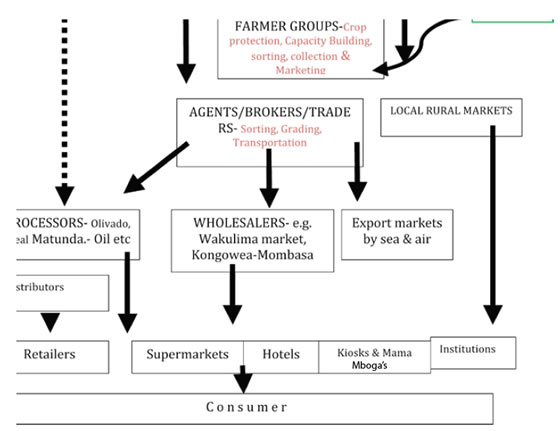 Packaging and Sizes: Each market has its own packing requirements. But generally, Avocados must be handled with care and packed and padded in single or double-layer boxes or cartons for shipment. The fruits must be removed from the cold stores only for a very short period of time for grading, sizing and packing.
Packaging and Sizes: Each market has its own packing requirements. But generally, Avocados must be handled with care and packed and padded in single or double-layer boxes or cartons for shipment. The fruits must be removed from the cold stores only for a very short period of time for grading, sizing and packing.
Fresh avocados are marketed in telescope folding cardboard boxes, preferably in open trays made of solid or corrugated board, with reinforced corners and stacking edges. Packaging is intended to preserve the quality of the fruit during the whole transport and marketing and protect the fruit against impacts and vibrations.
To comply with the European packaging regulations the packaging cannot be waxed and should be of recyclable material. The standard packaging size, to be observed to ship towards Europe, is 35 x 28.5 x 9 cm dimension which enables the optimization in standard pallets. The box must have adequate ventilation holes (10% of the surface).
Avocado for the European market should be packed in counts 10-12’, 14-16’, 18-20’ or 22-24’ in 4 kg boxes; sizes 8’ and 26’ are also used but less common. The boxes must be such a way that the bottom layer cannot suffer damage as a result of the pressure caused by the weight of the layers stacked on top of it. In the United States avocados are packed in boxes of 5.67 kg or 11.34 kg (43 x 32.6 x 17.5 cm. for the 11 kg box.); in the Japanese market boxes are for containing 6 kg of the fruit (43.9 x 33.1 x 11 cm).
Transport: Avocados can be shipped by sea and airfreight provided that all recommendations concerning postharvest treatment have been followed. Only the product that have been properly prepared and cooled can afford transportation without suffering any damage.
Transport is considered successful if the fruit is virtually ripe when arriving and can be kept fresh by the recipient for another ten to twelve days at 10-15°C and 90% Relative Humidity until is sold. Boxes must fit exactly in the pallet or in the container and must not be shaken during loading and unloading. In the case of sea freight, continued refrigeration is essential (at a minimum temperature of 5°C). Fruits can be shipped for 22-24 days in mid-season and no longer than 20 days at the end of the season.
Kenya Needs Investors in Avocado Processing.
After a boring technical lesson for a writer, I couldn’t cure my curiosity without talking about investment in value addition. “Avocado fruit oil is very important in cosmetic industry as well as product for making cooking oil is there room to invest in value addition”? I asked. “As volumes pick up it is important to ensure that the secondary markets develop to take up the extra volumes that will not be exported nor consumed fresh in the local market”, said my host. The options are oil extraction, guacamole, and frozen paste, processing into refined oil for cooking, salads and for cosmetic use. Currently there are four processors who extract oil that is then exported in its raw form to importers who then carry out the final processing and refining. This Meant there is more room for Investment.
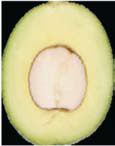 Reed
Reed
This variety of Califprnia origin has succeded in conserving the qualities of its parents ‘Nabal’ and ‘Anaheim’ without their negative features. Spheroid , with medium thickness , has slightly rough pliable ski. Average weight is 400 to 500g, oil content 19 to 20%
 Hass
Hass
It has dark green and brown at maturity skin, not very thick, warty, small seed. Average weight is 250g to 350g., the oil content is 20%. Fruits vary in shape in some production regions , ranging from pyriform to ovoid. The fruits size is fairly small in hot regions
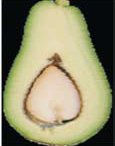 Ettinger
Ettinger
This variety was breed from Fuerte in Israel where it is mainly grown; the fruits are simila to those of Fuerte. Narrowly obovate, has bright green , fine and fairly smooth skin and fairly large seed. Average weight is 250 to 350g., the oil content is 18 to 22%
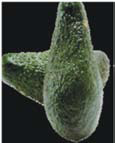 Pinkerton
Pinkerton
This recent variety was breed in California and is probably the result of a Hass X Rincon cross. Pyriform, has dark green, rough, tough and pliable skin , medium thick and easy to peel. Average weight is 270 to 400g., oil content 18 to 25%.
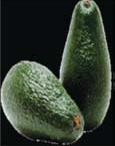 Fuerte
Fuerte
It originated in Mexixo. Of obovate shape, has green, matt , smooth, medium thickness skin, pliable and tough, easy to remove. Average weight is 250 to 400g, oil content is 16-18% and seed is large.
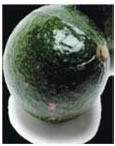 Nabal
Nabal
Medium to large in size has greennear skin nearly smooth, thick and granular. Flesh is of high quality, oil content vary from 10-15 to 18 to 22%, seed is small, tight.
